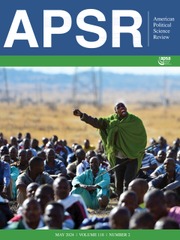No CrossRef data available.
Article contents
Public Perceptions of Minority Inclusion and Feelings of Political Efficacy: A Replication, Validation, and Extension
Published online by Cambridge University Press: 18 February 2025
Abstract
Stauffer (2021) shows that when Americans perceive their legislatures as having more gender diversity, they perceive these institutions to be more responsive. In this letter, we use an independently fielded survey to validate Stauffer’s findings and investigate whether her findings extend to race. We successfully replicate Stauffer’s analyses. We also newly demonstrate that perceptions of Black representation in legislatures are related to increased external efficacy, and perceptions of gender descriptive representation are associated with increased trust. Such findings underscore the importance of studying citizens’ perceptions of descriptive representation to understand their attitudes toward government.
- Type
- Brief Report
- Information
- Copyright
- © The Author(s), 2025. Published by Cambridge University Press on behalf of American Political Science Association



Comments
No Comments have been published for this article.